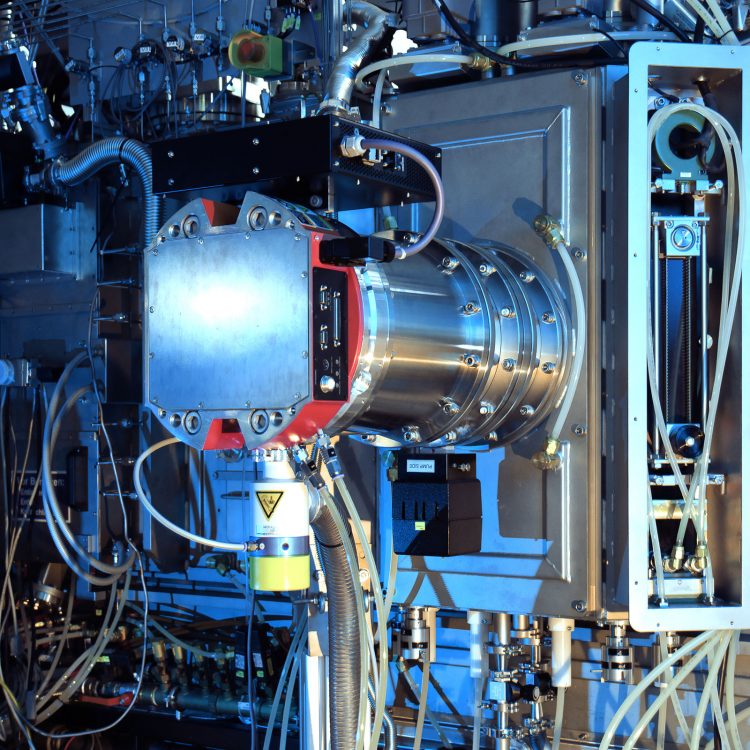Variable glass coatings to stop condensation on windows

The Megatron® enables the scientists at Fraunhofer IST to create new combinations of materials. © Fraunhofer IST/Jan Benz
When it’s frosty outside and cozy and warm indoors, a little bit of heat always escapes through the windows. Triple glazing is intended to keep as much of the expensive heating energy inside the house as possible, but this solution also has its downside, which is most noticeable at nightfall and in the early hours of the morning.
The drop in outside temperature causes the outermost pane to cool down significantly overnight, and moisture in the air is deposited as condensation. The result is misty windows. A conductive coating on the outer pane could stop condensation by preventing the small quantity of heat that penetrates the outer pane from being radiated to the cold outdoor environment.
This coating must also be scratchproof to withstand the weathering effects of wind and weather. Indium tin oxide, a material used to coat touchscreens, offers these properties. But its one major disadvantage is cost: indium is very rare and therefore expensive. If triple-glazed windows were to be coated with this material, their already high price would climb even higher.
Megatron® offers fast route to the optimum coating
The Megatron® sputtering system, developed in-house by researchers at the Fraunhofer Institute for Surface Engineering and Thin Films IST in Braunschweig, opens the way to the development of entirely new coating systems – for applications of all kinds. In the case of triple glazing, the researchers have opted for a solution based on titanium oxide.
“Titanium is much cheaper than indium, but it isn’t conductive,” says IST group leader Dr. Volker Sittinger. “So we dope the titanium with niobium.” In other words, the researchers deliberately contaminate the coating material in order to make it conductive. But how much niobium is needed to optimize the glass pane’s anti-misting properties? Until now there was no easy way to answer this question – until the Megatron® came along. “Unlike conventional sputtering systems, the Megatron® allows us to vary the doping concentration to any required level. It also enables us to increase the coating rate and obtain a smoother surface,” says Sittinger.
Conventional sputtering processes involve bombarding a solid object such as an ingot of titanium, referred to as the target, with energy-rich ions in a vacuum chamber. These ions knock a number of titanium atoms out of the target material, which are deposited on the glass substrate in the form of a very thin film. The doping process normally requires the presence of niobium ions in the target material, but this also implies that the concentration of this element is defined from the outset. The Megatron® system developed by IST researchers takes a different approach. “In this case we have two separate targets, one made of titanium and the other of niobium. This gives us total freedom to define the doping concentration. We can vary it in any way we choose, and even produce gradients, i.e. progressively increase or decrease the concentration of dopant within the thickness of the film,” explains Sittinger. This method can be used, for example, to enhance the efficiency of solar cells.
Coatings based on new combinations of materials
The Megatron® also allows entirely new coatings to be created by combining materials in a film that cannot be mixed in the form of a target, and were therefore impossible to produce up to now. For instance, a combination of tungsten and titanium dioxide could be used to create self-cleaning surfaces for interior spaces. When UV light hits a film of pure titanium dioxide, it breaks down any organic particles found there. If the titanium dioxide film is doped with tungsten, the organic dirt particles are broken down and detached when exposed to natural daylight.
Before building the Megatron®, the scientists carried out simulations to answer questions such as: What is the best way to separate the gas systems of the two vacuum chambers containing the different targets? What baffles are required, and where should they be positioned? The simulations enabled Sittinger and his colleagues to find the appropriate solutions, and the software developed by the IST team is already being used by the R&D departments of industrial plant manufacturers. The researchers will be presenting the Megatron® itself at the glasstec trade fair in Düsseldorf from October 21 to 24 (Hall 15, Booth A33).
Media Contact
All latest news from the category: Trade Fair News
Newest articles

Parallel Paths: Understanding Malaria Resistance in Chimpanzees and Humans
The closest relatives of humans adapt genetically to habitats and infections Survival of the Fittest: Genetic Adaptations Uncovered in Chimpanzees Görlitz, 10.01.2025. Chimpanzees have genetic adaptations that help them survive…

You are What You Eat—Stanford Study Links Fiber to Anti-Cancer Gene Modulation
The Fiber Gap: A Growing Concern in American Diets Fiber is well known to be an important part of a healthy diet, yet less than 10% of Americans eat the minimum recommended…

Trust Your Gut—RNA-Protein Discovery for Better Immunity
HIRI researchers uncover control mechanisms of polysaccharide utilization in Bacteroides thetaiotaomicron. Researchers at the Helmholtz Institute for RNA-based Infection Research (HIRI) and the Julius-Maximilians-Universität (JMU) in Würzburg have identified a…



